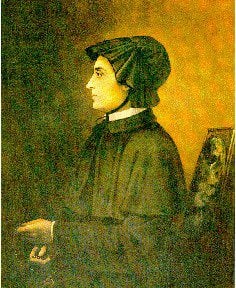
It’s Elizabeth Ann Seton’s feast day today. You know her — first American-born saint, founder of what became the Catholic school system in the United States, widow and mother. What follows is something of a re-write of my blog post from a couple years ago, with a bit of a different take in light of Cardinal Cupich’s new actions against the Traditional Latin Mass.
First, a mini-biography.
Elizabeth Ann Seton was raised as an Episcopalian, devout but also happy to enjoy life as part of the social elite of New York in the early years of independence. After marrying William Seton, of a well-to-do business family, she had five children, but the family business crashed and William suffered from tuberculosis, so they travelled with their eldest daughter to Italy in 1803, in hopes that the milder weather could improve his health, but he died shortly after arriving. For some time after his death, before she could arrange return passage, she stayed with the Filicchi family, business associates of the Setons, and Antonio and his wife Amabilia shared with her both the treasures of Italy and their Catholic faith. Elizabeth returned to the United States the following spring, and converted to Catholicism in 1805, whereupon she faced several years of rejection by her family and struggle to support her children before, with the financial support of benefactors, she founded a school for poor children and a religious order, the Sisters of Charity. She died on January 4, 1821.
This is some particular festival here — Mrs. F. took me with her to mass as she calls it, and we say to church — I don’t know how to say the awful effect at being where they told me God was present in the blessed sacrament, and the tall pale meek heavenly looking man who did I don’t know what for I was the side of the alter, so that I could not look up without seeing his countenance on which many lights from the altar reflected, and gave such strange impressions to my soul that I could but cover my face with my ands and let the tears run — oh my the very little while we were there will never be forgotten though I saw nothing and no one, but this more than human person as he seemed to me. (p. 131, Feb 2, 1804 in her journal, written as addressed to her sister-in-law)
Then on February 10th (p 131-2):
these dear people are so strange about religion. I asked Mr. F, something I don’t know what about the different religions and he began to tell me there was only one true Religion and without a right Faith we could not be acceptable to God — O Sir then said I, if there is but one Faith and nobody pleases God without it, where are all the good people who die out of it — I don’t know he answered, that depends on what light of Faith they had received, but I know where people will go who can know the right Faith if they pray for it and enquire for it, and yet do neither, — much as to say Sir you want me to pray and enquire and be of your Faith said I laughing — pray, and enquire said he, that is all I ask you. so dearest Bec I am laughing with God when I try to be serious and say daily as the good gentleman told me in old Mr. Popes words, “if I am right O teach my heart still in the right to stay if I am wrong thy grace impart to find the better way.” not that I can think there is a better way than I know — but every one must be respected in their own —
the other day a young Englishman brought the blood from my very heart to my face in the church of Montenay where the F. families took Ann and I to a lovely part of the country where Mr. F. had been concealed by the blessed inhabitants of the covent during some political revolution, and they invited us to hear mass in their chapel, there this poor young Englishman at the very moment the Priest was doing the most sacred action they call the elevation, (after the bread you know is blessed with the prayers as they do when we go to communion) just at that moment this wild young man said loud in my ear this is what they call there real PRESENCE – my very heart trembled with shame and sorrow for his unfeeling interruption of their sacred adoration for all around was dead silence and many were prostrated — involuntarily I bent from him to the pavement and thought secretly on the word of St. Paul with starting tears “they discern not the Lords body” and the next thought was how should they eat and drink their very damnation for not discerning it, if indeed it is not there — yet how should it be there, and how did he breathe my Soul in me, and how and how a hundred other things I know nothing about.
My sister dear how happy would we be if we believed what these dear souls believe, that they possess God in the Sacrament and that he remains in their churches and is carried to them when they are sick.
She then returned to the United States and engaged in a period of study and deliberation documented by letters to the Filicchis and others, struggles compounded by the fact that Catholics were deemed to be the poor rabble of the city, finally in January 1805 writing in another journal account (p. 164-165):
I WILL GO PEACABLY AND FIRMLY TO THE CATHOLICK CHURCH – for if Faith is so important to our Salvation I will seek it where true Faith first begun, seek it among those who received it from GOD HIMSELF, the controversies on it I am quite incapable of deciding, and as the strictest Protestant allows Salvation to a good Catholick, to the Catholicks I will go, and try to be a good one, may God accept my intention and pity me.
On March 14, 1805, she made her profession of faith, and on March 20th, her first confession, and on March 25, her first communion, writing
At last Amabilia — at last — GOD IS MINE and I AM HIS — Now let all go its round – I HAVE RECEIVED HIM
The remainder of the volume is less interesting to me because it’s her correspondence, more journals, etc., from her post-conversion period and her years as Mother Seton. For more details, here’s a brief biography of her, and a lengthier one here.
Now, to be clear, my take on the Traditional Latin Mass vs. the post-Vatican II version is that, Cupich’s yammering about “unity” notwithstanding, different people can find meaning in different forms of worship. Many people, perhaps even the majority of Catholics pre-Vatican II, perceived of the Latin Mass as something to just check off their to-do list each week, not benefitting from it spiritually at all. Others now perceive the modern form the same way, as a very ho-hum obligation for an hour, with nothing particularly sacred about it. Especially in the modern world in which we have access to so much media with high-quality production values, a mediocre cantor or a priest with a heavy accent can detract from the “experience” if you expect to be uplifted by a “production” such as a contemporary Protestant church might give you.
But can you imagine Elizabeth going to a modern mass and feeling this same sense of the sacred that so moved her, let alone the conviction that the Real Presence was, well, real — not just something to be learned in a catechism class, but something profound?
I have attended Latin Masses. I have concluded that it’s not my jam. But at the same time, I believe that people who say that there is nothing of value in that liturgy make a mistake, especially at a point when church attendance has dropped off so sharply, not merely because of Covid but certainly compounded by that. There are certain efforts to make mass more attractive to people, but we will never succeed in bringing people in based on “entertainment value.”
Fundamentally, for those people who make the point of attending Latin Mass, they do so not because of a conviction that the post-Vatican II mass is invalid but because it is this form of liturgy which gives them the feeling that “something sacred is taking place.” And that’s worth thinking about.
Image: https://commons.wikimedia.org/wiki/File:Saint_Elizabeth_Ann_Seton_(1774_-_1821).gif; UnknownUnknown author [Public domain], via Wikimedia Commons (no higher-resolution image appears to be clearly enough in the public domain)











